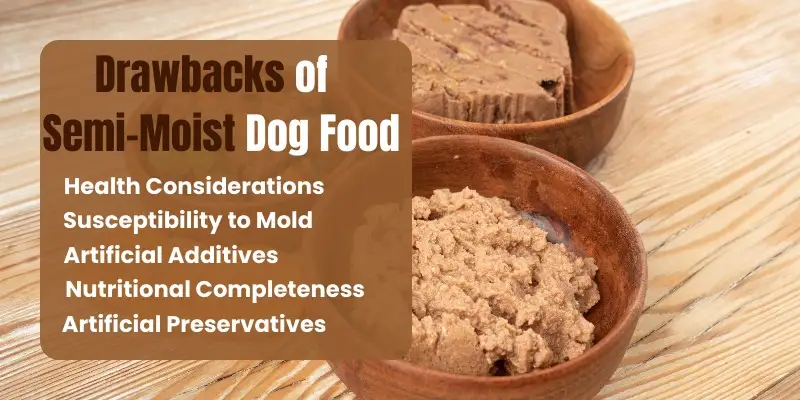Semi-Moist Dog Food: Is It Right for Your Dog? A Complete Guide
Published: 19 Feb 2025
Hello, pet parent!
Are you finding it hard to choose between dry kibble, wet food, and semi-moist dog food for your pup? With so many dog food options on the market, it’s easy to feel overwhelmed. Semi-moist dog food might seem like the perfect middle ground, but is it as good as it sounds?
Don’t worry—I’ve got your back! I’ll pour my four years of experience into this blog post, sharing valuable insights on semi-moist dog food, including its benefits, drawbacks, and how to choose the best option for your pup. Let’s get started!
What is Semi-Moist Dog Food?
Semi-moist dog food contains 60-65% moisture and is soft and chewy. It’s a good option for puppies, seniors, or pets with dental issues. This type of food strikes a balance between dry kibble and wet food. It often looks like small, tender meat chunks or treat-like bites, appealing to picky eaters.
Semi-moist dog food typically contains a mix of ingredients to enhance flavor, texture, and shelf life. Here’s what you might find in a typical semi-moist dog food:
- Meat and Animal By-Products: These provide protein and flavor. Common sources include chicken, beef, or lamb.
- Grains and Vegetables: Ingredients like corn, wheat, soy, and vegetable by-products add carbohydrates and fiber.
- Added Vitamins and Minerals: Ensure a balanced diet and support overall health.
- Artificial Flavors, Preservatives, and Humectants: They make the food more appealing to dogs but may not always offer nutritional benefits.
When choosing semi-moist dog food, always check the ingredient list. Aim for options with high-quality protein sources and minimal artificial additives to keep your pup healthy and happy!
How is Semi-Moist Dog Food Processed?
Ever wonder how semi-moist dog food gets its soft texture and rich flavor? Let’s break down the step-by-step process for making this unique dog food option!
1. Ingredient Selection and Preparation
High-quality proteins, grains, vegetables, fruits, and additives such as humectants and preservatives are selected. Ingredients are cleaned, measured, and prepared for processing.
2. Mixing and Shaping Process
The prepared ingredients are mixed thoroughly to form a consistent blend. This mixture is then shaped into bite-sized pieces, often resembling small, chewy chunks.
3. Extrusion or Forming Techniques
The mixture is pushed through an extruder or molded into specific shapes. The extrusion process involves heat and pressure, partially cooking the ingredients while helping maintain a soft texture.
4. Moisture Control and Preservation
Humectants like glycerin or propylene glycol are added to retain moisture and prevent the food from drying out. Natural (tocopherols) or artificial preservatives are included to enhance shelf life and maintain freshness.
5. Packaging and Quality Assurance
The semi-moist dog food is then sealed in airtight, shelf-stable pouches to lock in freshness. Before packaging, products undergo quality checks to ensure they meet safety and nutritional standards.
This detailed process ensures that semi-moist dog food is safe, palatable, and ready to meet your dog’s dietary needs. 😊
Benefits of Semi-Moist Dog Food
Semi-moist dog food isn’t just a tasty food; it offers several health benefits, including:
1. Palatability
Semi-moist dog food often has a flavorful and tender texture that makes it more enticing to dogs, especially those who turn their noses up at dry kibble.
2. Soft Textures
The soft and chewy consistency is gentle on the teeth and gums, making it a great option for older dogs or pets with dental problems.
3. Convenience
Semi-moist dog food is often packaged in individual pouches or small, sealed bags, making it incredibly convenient for busy pet owners. It requires no refrigeration until opened, and it’s easy to pack for travel, walks, or training sessions.
4. Training Applications
Because of its high palatability, semi-moist dog food can be broken into very small pieces and used as a high-value training treat. This can be very helpful when trying to teach your dog new commands or tricks.

Drawbacks of Semi-Moist Dog Food
While semi-moist dog food has its benefits, it’s important to consider some potential drawbacks before making it a regular part of your dog’s diet.
Health Considerations
Semi-moist foods may contain higher levels of sugar and salt than dry or canned foods, which could concern dogs with specific health conditions such as diabetes or heart disease.
Susceptibility to Mold
Due to their higher moisture content, semi-moist pet foods can be more prone to mold growth and mycotoxin production if not properly preserved.
Artificial Additives and Preservatives
Semi-moist dog food often includes artificial colors, flavors, and preservatives to maintain texture and shelf stability, which may not always be ideal for a dog’s health.
Nutritional Completeness and Balance
Some semi-moist foods might not provide a fully balanced diet, especially if used as the primary food source. It’s important to check whether the product meets AAFCO (Association of American Feed Control Officials) nutritional standards.

As a veterinarian with four years of experience, I’d recommend using it thoughtfully. It’s awesome as an occasional treat or training reward, but due to added sugars and preservatives, it may not be the best option for everyday meals.
How to Choose the Right Semi-Moist Dog Food
If you have decided to feed semi-moist food to your dogs, these few things you need to remember to get the maximum benefit:
- Check ingredients & analysis – Avoid fillers, sugar, and additives; ensure balanced nutrition.
- Match life stage & activity – Puppies, adults, and seniors need different nutrients.
- Consider dietary needs – Choose formulas for weight management or allergies if needed.
- Ask your vet – Get expert advice before changing your dog’s diet.
- Look for AAFCO approval – Ensure the food is labeled “complete and balanced”.
With these points in mind, you can confidently select the best semi-moist dog food that aligns with your dog’s health and lifestyle needs. 🐶😊
How to Transition to Semi-Moist Dog Food?
Switching your dog to semi-moist food? Here’s how to make the transition smooth and stress-free.
Gradual Introduction: Mixing with Current Food
When switching to semi-moist dog food, introduce it slowly. Start by mixing a small amount of the new food with your dog’s current diet. Gradually increase the proportion of semi-moist food over 7 to 10 days. This approach helps prevent digestive upset and allows your dog to adjust to the new taste and texture.
Monitoring Your Dog’s Reaction
During the transition, monitor your dog’s behavior and digestion. Look for signs like loose stools, vomiting, or changes in energy levels. Slow down the transition process or consult your veterinarian for guidance if any issues arise.
Portion Control: Due to High Palatability
Semi-moist dog food is often very tasty, which might lead your dog to overeat if not carefully portioned. Stick to recommended serving sizes and avoid using semi-moist food as the primary diet unless advised by your vet. Proper portion control helps maintain a healthy weight and prevents obesity.
By following these steps, you can ensure a smooth and safe transition to semi-moist dog food, keeping your pup happy and healthy! 🐶😊
You can use our calorie calculator to measure the calorie requirement according to your pet’s age, size, and weight.
Semi-Moist vs. Wet Dog Food: Which One’s Better
Wondering whether semi-moist or wet dog food is the better choice? Let’s compare both to help you decide.
| Feature | Semi-Moist Dog Food | Wet Dog Food |
|---|---|---|
| Moisture Content | Moderate (25-40%) | High (70-80%) |
| Texture | Soft and chewy | Soft and mushy |
| Palatability | Tasty, appealing to most dogs | Highly palatable, great for picky eaters |
| Shelf Life | Shorter than dry but longer than wet | Requires refrigeration after opening |
| Nutritional Value | May contain added sugars & preservatives | Usually high in protein & moisture |
| Convenience | Easy to serve, no refrigeration needed | Requires storage & portion control |
| Best For | Dogs needing a softer diet with convenience | Hydration support, senior dogs, or those with dental issues |
Which One Should You Choose?
- If you want a convenient, soft option with a longer shelf life, semi-moist food may be ideal.
- If your dog needs extra hydration, high protein, or has dental issues, wet food could be the better choice.
Ultimately, the choice depends on your dog’s specific needs, dietary requirements, and your convenience as a pet parent.
Conclusion
Alright, pet parents, here’s the scoop! 🍲🐶
After diving deep into the world of semi-moist dog food, I can say it definitely has its perks but use it as treats. If your pup loves a semi-moist diet, just make sure you choose a high-quality brand and keep an eye on portion sizes. And, of course, if you’re unsure whether it’s the right fit for your furry friend, don’t hesitate to consult your vet.
So, what do you think? Are you ready to try semi-moist dog food, or are you sticking with your pup’s current chow? Drop your thoughts in the comments, and let’s chat! 😊🐾
FAQs
Let’s discuss some commonly asked questions about semi-moist dog food.
Once opened, semi-moist dog food should be stored in an airtight container to prevent it from drying out or spoiling. Some brands may require refrigeration, so always follow the manufacturer’s instructions. For maximum freshness and safety, use the food within 2-3 days of opening.
Yes, semi-moist dog food can contribute to weight gain if overfed. Its high palatability and added sugars can make dogs more likely to overeat.
Semi-moist food may not always be suitable for dogs with sensitive stomachs due to added sugars, artificial preservatives, and certain humectants. If your dog has digestive issues, look for limited-ingredient semi-moist foods or consider consulting your veterinarian for personalized recommendations.
Yes! Mixing semi-moist food with kibble or wet food can add variety and enhance flavor. Ensure the combined diet provides complete and balanced nutrition by checking each food’s nutritional profile.
Yes, you can make homemade semi-moist dog food using fresh ingredients like lean meats, vegetables, and grains. Natural humectants like honey or glycerin can help retain moisture. However, homemade recipes may lack essential vitamins and minerals, so consult a veterinarian or pet nutritionist to ensure the diet is nutritionally complete.
Watch for signs like vomiting, diarrhea, excessive gas, itching, or behavioral changes after introducing semi-moist dog food. Monitor your dog’s weight and energy levels regularly to ensure the food is not affecting their health.
| Refrences! |
|---|
https://www.frontiersin.org/journals/microbiology/articles/10.3389/fmicb.2023.1188834/full?utm |

- Be Respectful
- Stay Relevant
- Stay Positive
- True Feedback
- Encourage Discussion
- Avoid Spamming
- No Fake News
- Don't Copy-Paste
- No Personal Attacks

- Be Respectful
- Stay Relevant
- Stay Positive
- True Feedback
- Encourage Discussion
- Avoid Spamming
- No Fake News
- Don't Copy-Paste
- No Personal Attacks





